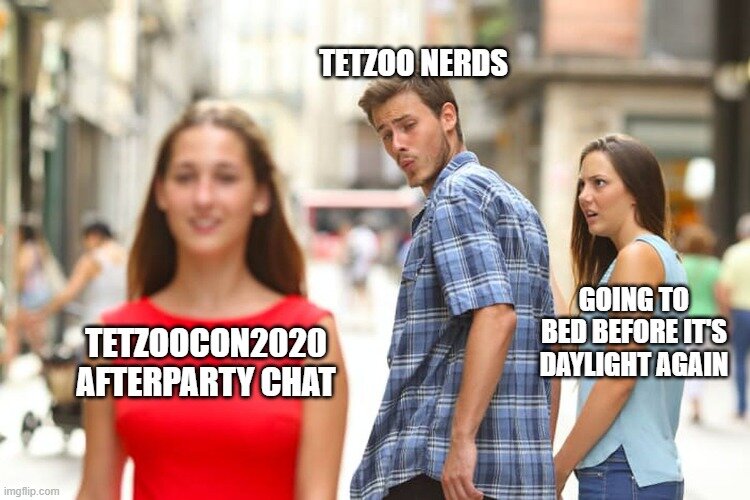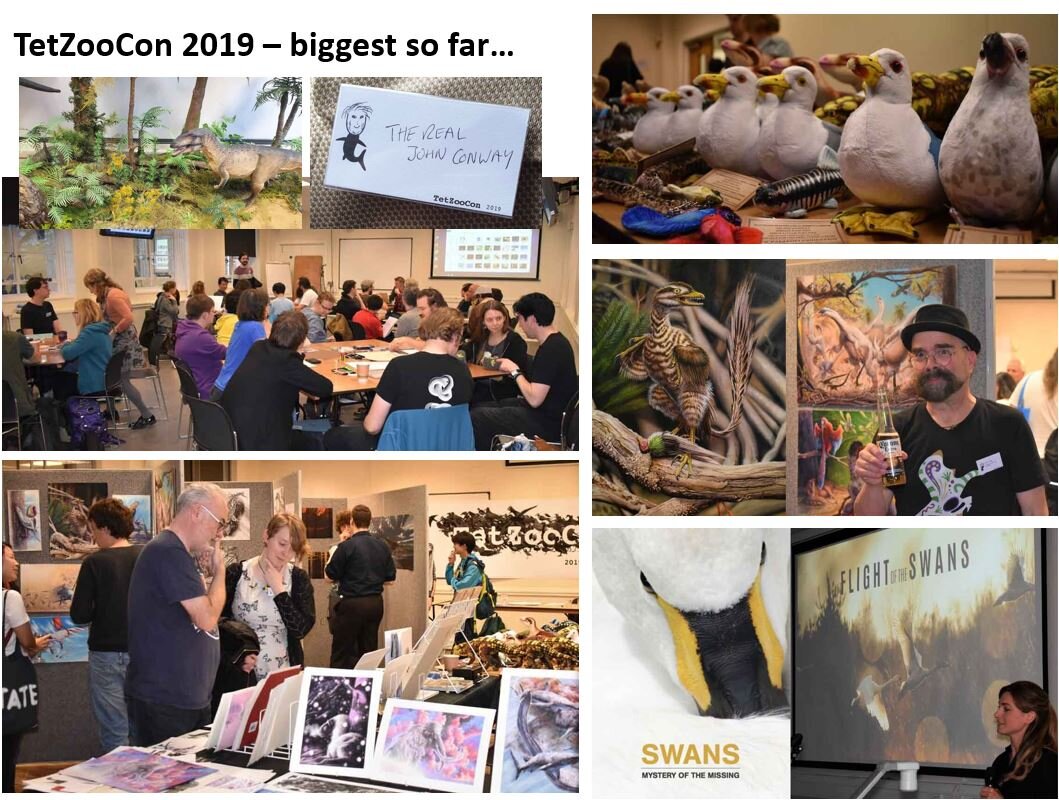Well, we did it. Opting not to hold a physical face-to-face TetZooCon 2020 for obvious reasons, myself, John Conway and Sharon Hill decided to make TetZooCon 2020 a zoom-only affair, and thus it was that TetZooMCon happened on Saturday December 12th, 2020.
Caption: a screengrab from the opening session (thanks to Evan Johnson-Ransom).
And what a success it was. Over 350 people from numerous locations worldwide joined us and a team of speakers and presenters to hear about, and discuss, all manner of subjects relevant to the TetZooniverse.
Caption: Anjali Goswami’s talk not only included her expression of undying love for salamanders, it also featured excellent and wonderful photo montages like this one. Image: Anjali Goswami.
TetZooMCon basically consisted of four segments: a bunch of talks, a British big cat discussion event, a palaeoart workshop, and a chaotic after-party. I’m pleased to report that all four segments ran to time and that each started when it was supposed to… just about. Our talks were on Neanderthals (Becky Wragg Sykes), the rise and fall of non-pterodactyloid pterosaurs (Natalia Jagielska), palaeoart as creature design (RJ Palmer), digitising vertebrates and what this tells us about evolution (Anjali Goswami) and recently extinct birds and their possible survival (David Lindo). We wanted to have more talks (and could have had), but – speaking as someone who spends a lot of time on zoom – I was keen to keep the presentation side of the meeting on the short side. I should add that we had breakout events during the break: if you didn’t need to go eat or whatever, you could join a chat group and discuss matters relevant to the meeting.
Caption: Natalia Jagielska’s excellent illustrations proved fertile ground for conversion into memes. Natalia was not responsible for the labels here :) Image: Natalia Jagielska.
All of the talks were fantastic; our excellent speakers not only kept to time and did a great job of handling the questions we threw at them, they also succeeded in making their presentations great fun to look at. From Rebecca’s images of Neanderthal tools and reconstructions (Neanderthals can look hot and appealing indeed) to David’s photos of tragically extinct birds, Anjali’s jaw-dropping digital composites and Natalia’s distinctive and wonderful cartoons and palaeoart, just…. wow. And it goes without saying that creature designer and palaeoartist RJ Palmer’s presentation was truly a visual treat, I loved it. Judging by the live-chat happening at the same time – damn it was active and busy – everyone else loved it too.
The British big cat event. Following from the tradition (I use the term loosely) established during TetZooCon 2017 and 2018, I wanted a discussion panel event. This time we focused on something I have a long-time interest in, and which is also timely in view of a soon-to-be-released feature-length documentary. Namely: British big cats! Yes, I think this subject is fascinating whether you regard it as an esoteric and wholly sociocultural event or an actual, valid, natural history phenomenon with links to rural economy, ecology and the rewilding debate. For the record, I am just about convinced that this is indeed an actual, valid, natural history phenomenon given the large quantity of field evidence that exists.
Caption: a screengrab from the British big cats workshop intro, by Darren Naish (thanks to Neil Balchan).
The documentary in question is Matt Everett’s Britain’s Big Cat Mystery; it’s not yet released but hopefully will be soon. Matt and I discussed his reasons for making the film, the approach he took, and how he managed to co-operate with a research community which is sometimes a little difficult to penetrate. I then handed the reins over to ecologist, environmental consultant and author Rick Minter who discussed his own take on the ‘deer-killing cats of Britain’ (there are reasons why we might not necessarily call all the animals ‘big cats’) before introducing eyewitness and investigator Matt James and ecologist and naturalist Leo Willis. Leo is working on some of the relevant field data as part of an academic study and will hopefully be publishing it soon.
The palaeoart event. British big cats out of the way, we moved on to the palaeoart workshop. This was more exclusive than the main event since we could ‘only’ allow for the interaction of around 140 people. We were joined by a team of leading palaeoartists (Raven Amos, Midiao Diallo, Rebecca Gelernter, Scott Hartman, Joschua Knüppe, David Krentz, Julio Lacerda, Bob Nicholls, Jed Taylor, Gabriel Ugueto, Steve White, Emily Willoughby and Mark Witton), who led teams of people in an exploration of palaeoartistic concepts and techniques. Their approaches were diverse. Some explained how to sculpt creatures using software, others led drawing classes, and others discussed their experience of the field from a personal point of view.
Caption: an indication of some of the talent present in the palaeoart workshop, dominated in this instance by coelurosaurian theropods. Clockwise from upper left, the images are by Avatar of Voyeuristic Terror, Matt Dempsey, Natee Himmapaan and Jack Mayer Wood.
A substantial amount of art was generated, most of it impressive and some of it simply amazing. A fair bit of this was shared on social media, and a few of the images are shown here. On the subject of shared art, a few people also shared work produced in direct response to the TetZooMCon talks and discussion topics. I mostly have in mind the amazing panels made by Mark Simmons (@toysdream on Twitter; website here), shown here (and shared with permission). Aren’t they incredible?
Bringing things to a close. With the palaeoart event finished, it was time for the party. You were encouraged to bring your own alcohol, should you wish. A pretty good number of attendees joined in, all manner of things were discussed, and there was about as much mingling and moving around as you can have via a zoom call. The party eventually finished…………. at about 2.30pm the following Sunday. Yes, a hardcore posse who shall remain nameless stayed up throughout the night and right through the morning and part of the afternoon of the following day. That’s dedication.
Caption: thanks to Gothmog Dave.
And thus things had – finally – come to an end. I’m pleased to say that TetZooMCon ran very smoothly, that we had none of the digital interruptions, internet failings or no-shows from speakers I was fearing. Turnout was good, and satisfaction with the event was pretty high so far as I could tell from comments and discussion. Our attendees came to us from – in approximate order – the USA, the UK, Canada, Germany, Australia, Italy, South Korea, Brazil, the Netherlands, Japan, France, Singapore, Sweden, Switzerland, Ireland, Russia, Mexico, Finland, Norway, Spain, Austria, Hungary, Poland, Bulgaria, Denmark, India, Malaysia, Cyprus, Chile, Ecuador, Argentina, South Africa, UAE, Israel, New Zealand and Guadeloupe.
Yes, events were mostly recorded (albeit not the palaeoart workshop sessions; people have to be allowed to ask all sorts of questions without this being on the record). At the time of writing we haven’t sorted out how we’ll release the material. What’s most likely is that it will probably be made available to those who already paid to attend, and that a small fee will allow access to anyone else.
What will the future bring? Will zoom-based events like this continue even after life has returned ‘to normal’, or will we continue to want these meetings, perhaps running alongside – or, in addition to – normal face-to-face arrangements? At this stage, it’s not possible to say, but I will say that I’m left with sufficiently positive feelings to want to do it all again.
Caption: a reminder of what things were like back when we used to meet people. The 2019 TetZooCon was huge, and we were all set in 2020 to move to an even bigger, better venue…
Thanks to John and Sharon for their help in running events, to Jenny for zoom-based help, to our excellent speakers, presenters and palaeoartists, and to everyone who attended, commented on Twitter (#TetZooMCon) or in the chat, or made it the great social event it turned out to be.
















